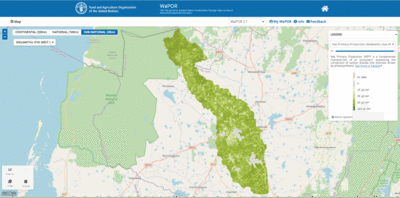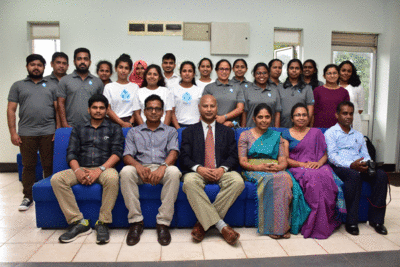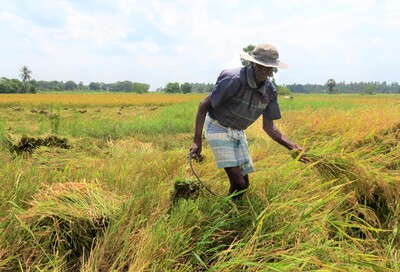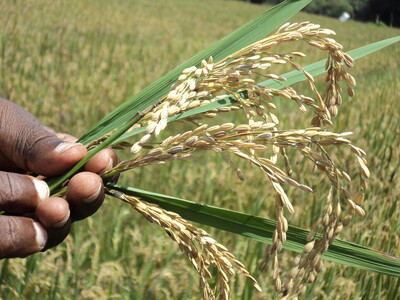Reaping the fruits of data in the paddy in Sri Lanka
FAO’s Knowing Water Better – towards fairer and more sustainable access to natural resources (KnoWat) project conducted a water accounting and auditing assessment in Sri Lanka to improve water resources management.
In Sri Lanka, an island in the Indian Ocean, a shimmery green river snakes through paddy fields and forests, unhurriedly towards the ocean in the northern part of the country. The 164-kilometer long Malwathu Oya river is the second longest river in the country and a lifeline for people living nearby.
The river’s southern catchment supports around 200 000 local people, who are mostly engaged in farming, providing them with water for drinking, sanitation, hygiene, and to irrigate their paddies.
The cultivation of rice has been practiced here for thousands of years: ancient civilizations flourished in the dry area of the country partly due to their irrigation systems. Sri Lanka was once known as the ‘granary of the east.’
To this day, the cultivation of rice is essential to Sri Lanka’s people, their culture and the economy: 43 percent of all agriculture lands are under paddy, and rice contributes to 1.8 percent of country’s GDP.
But in recent times, some paddies have been unable to produce, due to the impacts of climate change and related extreme weather events, such as prolonged droughts and fierce floods.
"Drought destroyed the harvest of one cultivation season in 2012 and then we had floods submerging our paddy fields. Our crops have been destroyed twice by floods since 2016," explained W.A. Ramani Perera, President of the Ranketha Farmer's Association and Treasurer of the Farmer's Association.
Since most of the southern catchment’s inhabitants are engaged in farming, a lost harvest means the loss of an important part of their income and even food – normally the farmers have two harvests per year. This begged the question: what could be done to plan and manage better water resources in the southern catchment to control floods and to ensure enough water for irrigation, even during dry periods?
Cutting-edge data and intense training
From 2019 to 2022, FAO’s KnoWat project carried out a number of activities in the Malwathu Oya southern catchment and at the national level to improve water resources planning and management.
The first step was to establish a near-real-time database on agricultural water consumption and water productivity, building on FAO’s Water Productivity Open-access portal (WaPOR). The database was created by analysing satellite images and comparing them to on-the-ground observations.
Prior to the project, data and information was inadequate to allow proper planning and management of water resources. The water balance was done by hand and based on field observations, requiring a great deal of time and energy.
“[Manually g]athering …[all of the] hydro-metrological and climatic data needed [for] assessing and improving water resources was difficult …,” confirmed Medhani Jayakody, Chief Engineer of the Water Resources Planning Branch at the Irrigation Department of Sri Lanka.
The WaPOR data from the catchment, as well as national data at different resolutions, are now freely available to water resource management officers for conducting water balance studies.
“Allowing [us] to use near real-time data with acceptable resolutions, WaPOR is going to bridge the gaps in data, cut down the cost and filling the gaps in new technology in water resources assessment” said T. K. A. Kodippili, an engineer at the Irrigation Department of Sri Lanka.
The KnoWat project also built the capacity of local people to use the WaPOR database.
Thirty men and women from different water sector agencies in Sri Lanka received training on water accounting and auditing. In addition, the project engaged with the next generation of water decision-makers, by assisting universities to include WaPOR on the curricula of agronomy students and to incorporate WaPOR into research projects.
Today, engineers, water management experts and academics can get a wealth of information from WaPOR that will help them to find solutions for managing water better in catchments and irrigation schemes.
“Using water productivity assessments at scheme level will be important in seasonal planning for better water management, and the decisions can be made …[at the start] of the season on the best crop type, water quantity to be used,” explained Medhani A. Jayakody..
Water resources managers reap the benefits of the data, but farmers are the ultimate beneficiaries.
“A farmer who lives in a remote village does not know anything about WaPOR, but can benefit from WaPOR through a designed plan for proper water management after assessing the water productivity on …[their] plot. The benefit they will receive is a good harvest due to having improved water management and seasonal planning. The good plan can ensure them a good income from their cultivations,” explained T.K.A. Kodippili.
Moving forward with new knowledge
Water managers have long maintained that good water resources management is critical to the equitable access and use of water.
In times of water-related challenges, such as brought on by climate change, water accounting and auditing are essential aspects of planning water resources management. Water accounting involves the systematic examination of the status and trends in the availability, demand, accessibility and use of water. Water auditing, on the other hand, examines trends in water supply, demand, accessibility and use in the broader framework of governance, institutions, public and private expenditure, law and political economy. When combined, results from water accounting and auditing facilitate policy development and decision-making.
The KnoWat project carried out a water accounting and auditing assessment in Sri Lanka’s Malwathu Oy southern catchment, as well as a water productivity study in an area identified as having low water productivity.
The water accounting study focused on ten subwatersheds in the Malwathu Oya southern catchment over four seasons. In each case, water balances were calculated using the Soil and Water Assessment Tool (SWOT), which is commonly used by the Irrigation Department of Sri Lanka, with inputs from the WaPOR database. These balances were compared with observed hydrological data. The flows calculated with SWOT and WaPOR were generally higher than the observed flows, by about 4 to 13 percent. This indicates that the model replicates the situation on the ground quite well and can be used in future water balance studies.
The water auditing case studies focused on three cases of unsustainable water management: i) water sharing between agriculture and domestic water uses and the unavailability of water from a tank in Thuruwila; ii) the Nuwara Wewa feeder canal and the illegal use of water; and iii) areas of low water productivity in the Nachchaduwa irrigation scheme.
In Thuruwila, it was discovered that by improving collaboration between farmers and area officials, the farmers were encouraged to share their practical knowledge in the high-level discussions, helping to resolve the water-sharing issue. In the Nachchaduwa-Nuwara Wewa feeder canal, officials concluded that the use of water for irrigation should be legalized because siphoning is difficult to control. In the Nachchaduwa irrigation scheme, the study revealed that inadequate maintenance and cleaning have led to flooding and, as a result, low water productivity. The study called for improvements to the canal system and better facilities for accessing and using the canal infrastructure.
Each area has its own challenges related to water management. Thanks to the water accounting and auditing assessments and the validation workshops, the stakeholders and decision-makers have now more information [on which] to base their decisions for development, explained Thushara Ranasinghe, KnoWat project’s National Coordinator in Sri Lanka.
A strong focus on water management is critically important for Sri Lanka, as the population continues to increase and climate change increasingly impacts the food security of rural people.
…[T]he challenge of the decade is how to feed the planet’s growing population sustainably, amidst climate and water crisis? With more than 733 million people currently living in areas of high or critical water stress and a projected 30 percent increase in global water demand by 2050, water allocation has never been more important, said the project’s global coordinator, Benjamin Kiersch.
Over four years, from 2019 to 2022, the KnoWat project worked to improve water resources management in Rwanda, Senegal and Sri Lanka. The results of the project in the three countries will complement FAO’s work on water tenure, as it initiates a ’Global Dialogue on Water Tenure.’





